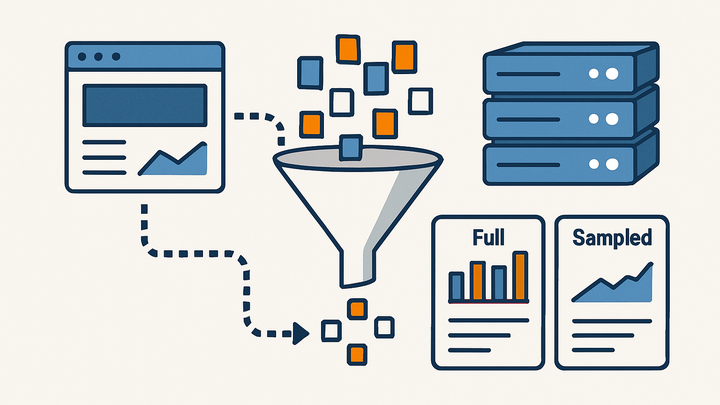Published on 2025-06-26T05:19:47Z
What is Query Sampling? Examples for Query Sampling.
Query sampling is an analytics process that processes only a subset of data points to generate insights when working with large datasets. It allows analytics platforms to deliver query results faster and more cost-effectively by scanning a representative sample instead of the entire data set. While this approach speeds up query response times and lowers computational loads, it introduces potential sampling bias, especially for small segments or rare events. In Google Analytics 4 (GA4), sampling kicks in when reports exceed certain thresholds, and it uses statistical inference to estimate full dataset metrics. PlainSignal, a cookie-free simple analytics solution, differentiates itself by providing unsampled aggregate metrics without compromising performance. Understanding how sampling works—and how to spot and mitigate its effects—is essential for accurate data interpretation. This article explores query sampling concepts, compares implementations in GA4 and PlainSignal, and offers practical examples and best practices.
Query sampling
Technique processing a subset of data to estimate full dataset metrics, balancing accuracy and performance in analytics.
Understanding Query Sampling
This section covers the fundamentals of query sampling in analytics, explaining what it is, why it’s used, and its impact on data accuracy and performance.
-
Definition
Query sampling is a method where the analytics system processes only a subset of the total dataset to quickly generate query results, rather than scanning all records.
-
Purpose
Sampling reduces computation time and costs when querying large datasets by trading off complete accuracy for faster performance.
-
Performance optimization
Reduces server load and speeds up query response times.
-
Cost efficiency
Lower processing costs by analyzing fewer data points.
-
-
Impact on accuracy
Since only a subset is analyzed, results are estimates that may diverge from exact values, especially for small segments or rare events.
Query Sampling in GA4 and PlainSignal
Compare sampling implementation in GA4 and PlainSignal simple analytics to highlight differences in approach, thresholds, and capabilities.
-
GA4 sampling mechanism
In Google Analytics 4, sampling occurs when querying data above certain thresholds in the UI, typically when more than 10 million events are processed. It uses BigQuery under the hood and applies statistical methods to extrapolate full results.
-
Sampling thresholds
UI reports sample when events exceed the processing limits, often 10M+ in custom reports.
-
Estimation methods
Applies statistical inference to approximate metrics from sampled data.
-
-
PlainSignal approach
PlainSignal’s simple and cookie-free analytics is architected for performance and privacy, capturing aggregated metrics without sampling to ensure full accuracy without sacrificing speed.
-
Cookie-free tracking
Tracks aggregate events without cross-site cookies, focusing on pageviews and sessions.
-
No sampling guarantee
All collected events are included in reports across all time periods.
-
Practical Examples
Walkthroughs demonstrating how to identify and work with sampled data in GA4 versus PlainSignal, including code snippets and UI indicators.
-
GA4 query sampling example
In the GA4 interface, sampled reports display a shield icon with the sampling rate. To view unsampled data, you can export raw events to BigQuery.
-
Ui indicator
A shield icon appears next to report titles with a ‘Sampled’ label and percentage.
-
Bigquery export
Connect GA4 to BigQuery to access unsampled event-level data for precise analysis.
-
-
PlainSignal simple analytics example
PlainSignal provides unsampled aggregate metrics out-of-the-box. Add the tracking snippet below to your site to start collecting data without sampling:
<link rel='preconnect' href='//eu.plainsignal.com/' crossorigin /> <script defer data-do='yourwebsitedomain.com' data-id='0GQV1xmtzQQ' data-api='//eu.plainsignal.com' src='//cdn.plainsignal.com/plainsignal-min.js'></script>
Best Practices and Mitigation Strategies
Guidance on minimizing the effects of sampling bias and ensuring the reliability of analytics insights when sampling is unavoidable.
-
Adjust date ranges and filters
Limit query scopes to smaller date ranges or specific segments to reduce sampling rates in GA4.
-
Use unsampled data exports
For GA4, leverage BigQuery exports to run unsampled queries on complete datasets.
-
Validate with multiple reports
Compare results across different report types and dimensions to detect inconsistencies due to sampling.
-
Apply statistical adjustments
Calculate confidence intervals and margins of error to understand the precision of sampled estimates.
